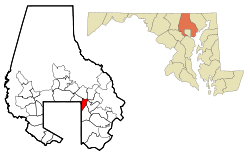Overlea, Maryland
Overlea is an unincorporated community and census-designated place in Baltimore County, Maryland, United States. The population was 12,275 at the 2010 census.[1] Students attend Overlea High School. Area roads include Belair Road (U.S. Route 1) and Kenwood Avenue (Maryland Route 588).
Overlea, Maryland | |
|---|---|
 St. Michael's Church, in October 2010. | |
 right | |
| Coordinates: 39°21′40″N 76°31′10″W | |
| Country | |
| State | |
| County | |
| Area | |
| • Total | 3.1 sq mi (8.0 km2) |
| • Land | 3.1 sq mi (8.0 km2) |
| • Water | 0.0 sq mi (0.0 km2) |
| Elevation | 226 ft (69 m) |
| Population (2010) | |
| • Total | 12,275 |
| • Density | 4,000/sq mi (1,500/km2) |
| Time zone | UTC−5 (Eastern (EST)) |
| • Summer (DST) | UTC−4 (EDT) |
| FIPS code | 24-59325 |
| GNIS feature ID | 0590957 |
Overlea includes the neighborhood of Fullerton.
Geography
Overlea is located at 39°21′40″N 76°31′10″W (39.361107, −76.519535).[2]
According to the United States Census Bureau, the CDP has a total area of 3.1 square miles (8.0 km2), all land.
History
Overlea first started out as a 43-acre tract, owned by Margaret Fuller (Fullerton, Maryland is named for her most likely). This tract started in 1858, just three years before the start of the American Civil War. She was a widow and brought her six children with her. Margaret Fuller originally hailed from Ohio. The 43 acre tract was referred to as "Sophie’s Garden Regulated". This original tract is located around the intersection of Belair Road and Taylor Avenue, along with the original house still standing there today. In 1885, the first Post office and general store were established. Later in 1886, Fullerton School was established as a one roomed log house, and was rebuilt as a frame house. Overlea began to truly develop in 1895 when the Kennard Land Company bought Lange's Farm (either Fuller's original tract, or a different tract, or possibly both). Kennard Land company mapped out the streets as: Spruce, Ash, Cedar, Maple, Hickory, Chestnut, Walnut, Willow, Beech, Poplar, Elm and Linden. Streets were named after trees. In 1910, a "town hall" was built on the Corner of Overlea Avenue and Belair Road, and still stands there today as the Natural History Society of Maryland. The town hall served as a grocery store as well. In 1913, the Women's Suffrage Movement made a stop in Overlea on their way from Washington D.C. to New York City. They held a meeting in the town hall, and although many were not sympathetic, a few showed support. In the same year, St. Michael's Roman Catholic Church held its first mass in the town hall. In 1919, The City of Baltimore annexed a portion of Overlea to what is now Overlea, Baltimore.[3]
Demographics
As of the census[4] of 2000, there were 12,148 people, 4,951 households, and 3,317 families residing in the CDP. The population density was 3,950.6 people per square mile (1,522.8/km2). There were 5,152 housing units at an average density of 1,675.4/sq mi (645.8/km2). The racial makeup of the CDP was 87.74% White, 8.78% African American, 0.30% Native American, 1.79% Asian, 0.02% Pacific Islander, 0.23% from other races, and 1.14% from two or more races. Hispanic or Latino of any race were 1.39% of the population.
There were 4,951 households out of which 28.6% had children under the age of 18 living with them, 51.1% were married couples living together, 11.6% had a female householder with no husband present, and 33.0% were non-families. 26.9% of all households were made up of individuals and 12.0% had someone living alone who was 65 years of age or older. The average household size was 2.45 and the average family size was 2.99.
In the CDP, the population was spread out with 22.9% under the age of 18, 7.7% from 18 to 24, 30.8% from 25 to 44, 22.4% from 45 to 64, and 16.2% who were 65 years of age or older. The median age was 38 years. For every 100 females, there were 92.6 males. For every 100 females age 18 and over, there were 89.1 males.
The median income for a household in the CDP was $48,242, and the median income for a family was $57,075. Males had a median income of $40,349 versus $30,167 for females. The per capita income for the CDP was $23,402. About 3.6% of families and 5.2% of the population were below the poverty line, including 5.1% of those under age 18 and 7.7% of those age 65 or over.
Education
Overlea is home to Overlea High School which has a student body of 1,073 students as of the 2010 school year.[5]
References
- "Profile of General Population and Housing Characteristics: 2010 Demographic Profile Data (DP-1): Overlea CDP, Maryland". United States Census Bureau. Retrieved February 29, 2012.
- "US Gazetteer files: 2010, 2000, and 1990". United States Census Bureau. 2011-02-12. Retrieved 2011-04-23.
- "History." Overlea, Maryland | History. N.p., n.d. Web. 24 Apr. 2013. <http://www.overleaonline.org/history/>.
- "U.S. Census website". United States Census Bureau. Retrieved 2008-01-31.
- Maryland State Department of Education
| Wikimedia Commons has media related to Overlea, Maryland. |
